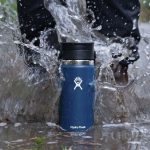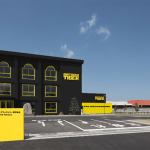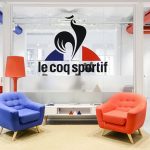Brands, Inc. reported first-quarter earnings rose to $38 million, or 59 cents a
share, from $19.7 million, or 30 cents, a year ago. Adjusting year-ago earnings
to exclude nonrecurring charges, earnings were down 9.7% from $42.1 million, or
66 cents a share, a year ago. First quarter sales were down 7.5% to $862.9 million
from $932.4 million. Excluding year-ago sales related to the expired Tommy
Hilfiger adult footwear license, revenues were down 5.1%. Sales were negatively impacted by $15 million
due to foreign currency fluctuations.
.
Collective
Brands comps declined 4.8%. Without the unfavorable impact of foreign currency
rates, Collective Brands comparable store sales declined 3.2%. Comparable store
sales for Payless and Stride Rite declined 5.2% and 0.5%, respectively.
Collective
Brands generated $94.5 million of EBITDA during the quarter, up 23.9% versus
last year. Adjusted EBIDTA was down 9.7%.
.Free
cash flow was $30.7 million in the first quarter of 2009, up $28.5 million from
the prior year period. The company had total liquidity at the end of the
quarter of $492.7 million with $260.8 million in cash and cash equivalents and
$231.9 million of borrowing capacity available under its revolving credit
facility.
Gross
margins improved to 35.9% of sales from 32.7% a year ago on an actual basis and
from 36.4% on an adjusted basis. The gross margin was favorably impacted by
higher average unit retail prices at Payless and increased direct sourcing of
product through the company's vertically-integrated sourcing organization. The
rate was unfavorably impacted by merchandise cost increases, negative sales
leverage on occupancy costs, and additional Stride Rite Retail promotional
activity.
SG&A
expenses were cut to $ 249.3 million from $263.8 million a year ago on an
actual basis and $261.3 million on an adjusted basis. �The decline was
primarily due to cost reduction actions that reduced payroll and other
expenses.
Inventory
at the end of the first quarter was flat to last year at $480.7 million. Total footwear units at Payless were lower,
and Payless aged inventory remains low.
Capital
expenditures were $26.7 million in the first quarter of 2009 compared to $42.7
million last year. The lower
expenditures reflect the substantial completion of distribution centers and
reduced spending on stores. During the
first quarter, Collective Brands added 20 new stores (18 Payless and 2 Stride Rite), closed 21
stores (20 Payless and 1 Stride Rite), and relocated 12 Payless stores.
“Our
team continues to successfully execute our strategy in the current challenging
economic environment. During the first quarter, we increased our market share,
we lowered our operating cost structure, and we generated stronger cash
flows,” said Matthew E. Rubel, chairman, chief executive officer and
president of Collective Brands, Inc. “We achieved growth in our children's
retail businesses, and we continue to see strong growth at the consumer level
led by Saucony and Sperry.”
SEGMENT RESULTS
Payless Domestic: Payless Domestic's sales fell to
$570.8 million from $588.5 million a year ago. Operating profit reached $42.2
million, up from $35.1 million on an adjusted basis a year ago. After adding
back expenses related to litigation, inventory step-up and Tommy Hilfiger, of
$30 million, actual net operating profit was $5.1 million. -The 3.0% decline in
net sales was driven primarily by lower traffic offset by higher average unit
retail prices and increases in the children's and accessories businesses. Operating profit was higher due primarily to
litigation expense last year and SG&A and occupancy cost reductions this
year.
Payless International: – Payless International's revenues
slid to $84.8 million from $104.3 million. Operating profit was $1.8 million,
down from $11.4 million. Foreign currency rates negatively impacted segment
sales by $10.5 million. In addition, the
sales decline was driven by lower sales in
Latin America, and
to lower consumer traffic. Operating
profit declined due primarily to lower sales, increased costs to comply with
new regulations and taxes in
and initial start-up costs related to entering
Stride Rite Retail: – At Stride Rite Retail, sales inched
ahead to$58.5 million from $57.1 million a year ago. Operating profit of $2.2
million compared with adjusted profit of $5.1 million. Actual operating was
$1.6 million.
Sales
increased due to greater promotional activity, particularly at outlet stores,
as well as eight more stores versus the prior year. Operating profit increased due to purchase
accounting inventory step-up last year.
Excluding this adjustment, operating profit decreased due to the comparable
store sales decline and increased markdowns as a result of additional promotional
activity.
Stride Rite Wholesale: At Stride Rite Wholesale, which
includes Sperry Top-Sider, Saucony, Keds, and Robeez, revenues dipped to $148.8
million from $182.5 million. Excluding
Hilfiger, year-ago sales were $159.1 million. Operating profit reached $14.3
million compared with $23.1 million on an actual basis and $18 million on an adjusted basis. Sales declined due primarily to the expiration
of the Tommy Hilfiger adult footwear licensing agreement, lower Keds sales due
to its strategic repositioning, and foreign currency rates which negatively
impacted segment sales by $4.5 million.
These declines were partially offset by sales gains at Saucony. Operating profit decreased due to lower
sales, the expiration of the Tommy Hilfiger adult footwear licensing agreement,
and higher product costs. Amortization
of intangible assets due to the Stride Rite acquisition totaled $3.4 million in
the quarter.
Outlook for Collective Brands
The 2009
effective tax rate is expected to be 19%, excluding discrete events associated
with the resolution of outstanding tax audits.
Depreciation
and amortization in 2009 is expected to total approximately $145 million, due
to greater investments in supply chain and stores in recent years as well as
the 2007 acquisition of Stride Rite.
Capital
expenditures in 2009 are expected to total approximately $85 million.
Collective
Brands 2009 retail store count is expected to decline by 60, net of store
openings.















